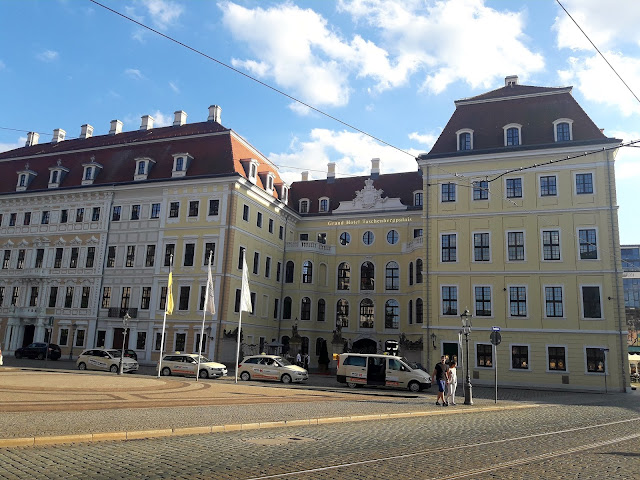Dresden’s Grandest Hotel was once a Palace Originally Built for a Notorious Royal Mistress
 |
| The Grand Hotel Taschenbergpalais in Dresden. Image by the Author |
Beside Dresden’s Royal Palace and the
Dresden Pavillon is an equally imposing baroque structure that surely grabs the
attention of travellers and passersby alike. This is the Grand Hotel Taschenbergpalais, once a regal residence fit for a royal mistress. The palace
was built by Johann Friedrich Karcher as a gift of Augustus II the Strong,
Elector of Saxony and King of Poland to his mistress, Countess Anna Constanze
von Hoym.
The Countess, born Anna Constantia, had
gained power and reputation through an early marriage which landed her the
title of Baroness, which she was able to transform into an eight year position
as the official mistress to the King.
Anna was the daughter of a knight and the
daughter of a Hamburg merchant. She was a concubine of Adolphus Magnus, Baron of
Hoym, before they married in 1703. Their marriage was not to last and when she
met Augustust II the Strong, Elector of Saxony and King of Poland, in 1704, the
couple were already estranged. They were divorced in 1706. When she arrived in
Dresden, Anna claimed she was still the baron's wife so she could appear at the
royal court.
Baroness von Hoym’s vivacity caught the
king’s attention and fell in love with her. Anna’s rise in the king’s court was imminent
although it also earned for her the enmity of the courtiers. Her former husband
thought she was unsuitable for a king’s mistress and attempted to prevent their
relationship, albeit unsuccessfully. The king’s pious wife, Christiane
Eberhardine of Brandenburg-Bayreuth, exiled herself, disgusted with the king’s scandalous
Polish court. Now, it was only the king’s other mistress the Princess Teschen
that Anna had to deal with.
Finally, in 1705, the Princess Teschen was
banished from the court, and Anna finally reigned as the king’s official
mistress. In 1706, she was elevated to the position of Imperial Countess
(Reichsgräfin) of Cosel. She gave birth to the king’s daughter on February 24, 1708.
The following year, she bore him another
daughter and three years after, a son who she named Frederick Augustus. He later
inherited Gut Depenau from his maternal grandparents. By giving three children
to the king, Anna thought her position at the Court was indisputable. However,
she interfered too much into politics to the point of meddling in Augustus'
Polish affairs. When Augustus fall into the charming Maria Magdalena Bielinski,
Countess von Dönhoff, alas, Anna’s position was threatened. She was first
banished to the Pillnitz Castle in 1713 but managed to escape to Berlin in
1915. She was condemned as a Landesverräter (state criminal) only to be
arrested in 1716. Augustus exiled his former mistress to Burg Stolpen, where
she remained until her death 49 years later.
 |
| Ruins of Taschenbergpalais in 1990. Image: Wikimedia |
 |
| Taschenbergpalais today. Image: Wikimedia Commons |
Since Anna’s downfall until the abolition
of the monarchy, Taschenbergpalais became the residence of the crown princes of
Saxony, known as the Turkish Palace. From the mid-18th until the 19th century, the palace was expanded and embellished.
Towards the end of World War I, the King of
Saxony abdicated in 1918. During World War II, Dresden became a communications and
manufacturing center, thus, the Allied forces made it one of their targets.
Taschenbergpalais, just like other heritage structures of Dresden, was severely
destroyed during the Bombennacht (night of bombs) on February 13, 1945. At the
end of the war, Saxony became part of the Communist-held East Germany and for the
next five decades, ruins of the palace
stood untouched and unnoticed. Finally, the palace was meticulously rebuilt
from 1992 until 1995 for a whopping 127.8 million euros in today’s value.
On March 31, 1995, the former palace was
opened as a hotel by the five-star chain Kempinski, the first-ever five-star
hotel in Dresden.


Comments
Post a Comment